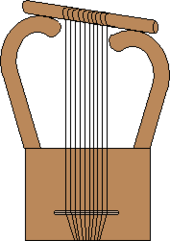Nevel (instrument)
The nevel or nebel (Hebrew: נֵ֤בֶל nêḇel) was a stringed instrument used by the ancient Hebrew people. The Greeks translated the name as nabla (νάβλα, “Phoenician harp”).[1][2]

Detail of the "Peace" panel of the Standard of Ur showing lyrist, excavated from the same site as the Lyres of Ur.

Schematic drawing of an ancient kinnor
 Ancient Nevel (Harp) | |
| Classification | String instrument |
|---|---|
| Related instruments | |
| Lyre, Kinnor, Kithara | |
A number of possibilities have been proposed for what kind of instrument the nevel was; these include the psaltery, and the kithara, both of which are strummed instruments like the kinnor, with strings running across the sound box, like the modern guitar and zither. Most scholars believe the nevel was a frame harp, a plucked instrument with strings rising up from its sound box.[3]
The King James Version renders the word into English as psaltery or viol, and the Book of Common Prayer renders it lute.[4].
The word nevel has been adopted for “harp” in modern Hebrew.
See also
References
- "nabla". Oxford English Dictionary (3rd ed.). Oxford University Press. September 2005. (Subscription or UK public library membership required.)
- Rich, Anthony (1874). A Dictionary of Roman and Greek Antiquities. New York: D. Appleton & Company. p. 439.
- Joachim Braun (2002). Music in Ancient Israel/Palestine: Archaeological, Written, and Comparative Sources. Wm. B. Eerdmans Publishing. p. 23. ISBN 978-0-8028-4477-4.
- Neil, James (1913). Everyday Life in the Holy Land. London, UK: Cassel & Company, Ltd. p. 218.
This article is issued from Wikipedia. The text is licensed under Creative Commons - Attribution - Sharealike. Additional terms may apply for the media files.